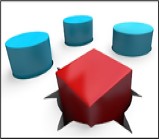Let’s say you just got back from IKEA.
And in the trunk of your car is a fairly heavy box with your new desk.
Unfortunately, you’re an assemble-first, read-the-directions-later sort of person.
And pretty soon you’ve bent the hex wrench provided, stripped the threads off a screw, broken one of those cute-little wooden pegs, and the desk legs are heading in different directions.
Hmmm… maybe it’s time to take those annoying directions out of the sealed plastic bag.
That’s what we usually see when we critique our new members previous copywriting attempts.
 It’s often a mish-mash of different theories and swiped chunks of copy, jammed together in round-peg-in-square-hole fashion.
It’s often a mish-mash of different theories and swiped chunks of copy, jammed together in round-peg-in-square-hole fashion.
Which is why formulas can be such a blessing.
Because they’re like blinders on a horse… they eliminate distractions, keep your eyes on the prize, and allow you to go in ONE direction only, instead of a dozen.
Not only that, you don’t have to reinvent the wheel every time you start writing.
But there are so many recommendations out there, what’s the best one to use?
Good question, and we’ve got answers.
So here are our fav copywriting formulas, along with our proprietary email formula that we’ve developed, tested, and honed to perfection by sending millions of emails over the years.
Simple and Fast: Kick Writer’s Block to the Curb!
“You don’t have to see the whole staircase to take the first step.” – Martin Luther King
Or similarly, Mark Twain said:
“The secret of getting ahead is getting started. The secret of getting started is breaking your complex, overwhelming tasks into small manageable tasks, and then starting on the first one.”
That’s another reason to use a formula — because you can “chunk down” your project, whether it’s an ad, a video script, an email, or a webinar.
In other words, you can BUILD the copy instead of trying to do it all at once.
 So if you’ve struggling with the opening line, BUILD the body instead.
So if you’ve struggling with the opening line, BUILD the body instead.
Get to work on your offer, write some bullets (even just one), or do anything else that gives you even the slightest bit of momentum.
That’ll help you get a mental toehold when taking on those overwhelming tasks.
For instance, here’s one of the most famous of all formulas, one that’s been working forever, and still is today.
You’ve probably seen it, but as Victor Schwab says in the introduction to his masterpiece, How to Write a Good Advertisement… “We need not so much to be instructed, as to be reminded”…
P-A-S: Problem – Agitate – Solve
It’s a simple one to keep in mind:
PROBLEM: State the problem so your prospects identify and resonate with your message.
An example is:
“Hey Jim,
Struggling with your finances is one of the most frustrating and depressing problems you can have.”
That hits them where they live, now it’s time to rev it up a bit.
AGITATE: Now push that pain button a bit harder, like this:
“Financial stress affects everything in your life… relationships, health… even your sleep.”
SOLVE: Then you, as their knight in shining armor, come to their rescue with your fabulous product or service:
“That’s why our breakthrough webinar will show you the secret to abundance… and a good night’s sleep!”
Two More Tried-and-True Formulas
The next-most famous formula has to be AIDA, which stands for… Attention – Interest –Desire – Action.
It’s been used in every conceivable media — video sales letters, direct mail, infomercials, emails, you name it.
In a nutshell, it goes like this:
Attention – Grab ‘em by the eyeballs with a hot subject line, headline, image.
Interest – Sustain their attention with something fascinating, informative, curiosity inducing, etc.
Desire – Roll out the benefits of what you’re selling and demonstrate HOW it delivers what you promise.
Action – Cut to the chase and ask for the sale, a sign up, a response to a survey, etc.
OK, here’s one more formula I think I learned from Mark Ford, who for decades has been one of the best writers on the planet.
It’s called “The 4 U’s.”
Useful – Demonstrate how you are USEFUL with your product or service.
Urgent – Create a sense of URGENCY with the consequences of inaction, or time pressure, or scarcity.
Unique – Prove to them that you’re one-of-a kind, irreplaceable, and UNIQUE.
Ultra-specific – Be super-SPECIFIC with everything you present.
As far as being specific, I always remember Zig Ziglar saying it’s important to be a “meaningful specific… not a wandering generality.”
Because vague statements have minimal impact, whereas numbers, locations, dates, specific people, etc., are much more credible.
The Proprietary SOD-PC Formula
Our exclusive SOD-PC formula, originally created for writing emails, is applicable to any media, which makes it one of the best in the biz.
It stands for Subject line, Opening, Deepening, Pitch, Call to action.
We’ve taught it to hundreds of our members over the last 10 years, and have used it to create astonishing profits in multiple campaigns.
Here’s how it works (I’ll show you the first two now, and the rest in an upcoming blog post).
1. The SUBJECT LINE
A great subject line does one or all of the following three things.
First, it INTERRUPTS THE PATTERN of the unconscious trance most people are living in.
You do this by breaking the pattern of scanning, with words and phrases that jump out at the person (examples below).
 Secondly, a great subject line also GENERATES CURIOSITY.
Secondly, a great subject line also GENERATES CURIOSITY.
Once these pattern-interrupting words and phrases have stopped the scanning, the reading of the subject line must create intense curiosity — a need to know what is inside the email.
Thirdly, a hot subject line PROMISES a RELEVANT BENEFIT.
If you want to set the stage for readership and conversion, you must also promise that opening and reading the email will move the reader toward pleasure and away from pain in a way that is consistent with the reason they subscribed to your email list in the first place.
Here are a couple examples.
Subject Line:
TRUE STORY: Suicide Pact for Success
This subject line was for a campaign series we wrote for the legendary Jon Benson, creator of the VSL (video sales letter).
The campaign generated over $400,000 in 16 days.
Here’s another example from a different client’s campaign.
Subject Line:
[80/20 Encore] Give Up Sleep for Optimum Productivity
This subject line was for an email to sell tickets to Perry Marshall’s annual 80/20 Summit, which hauled in $129,742 in just 9 days.
OK, now for the second part of the formula…
2. The OPENING
You already know that any sales piece works like a bucket brigade… handing off from one section to the next, as you move closer and closer to the call to action.
So after the subject line which gets them to open your email, you hand the ball to a strong opening that keeps them engaged.
Here are a couple of examples.
First, from an email campaign we created for Sue Heintze in Australia, who teaches women about body sculpting.
Sue brought in $51,836 in just 12 days.
The subject line was impossible to ignore, followed by a just-as-powerful OPENING.
Subject Line:
My Jiggly, Embarrassing Bum (see it on video)
Then we open with a story that picks up where the subject line left off…
Dear Sarah,
When I was 19, and still living in Mildura, one day I was innocently walking across the paddock where we kept my horse.
My Mum and my big sister Robyn were behind me.
They had a clear view of my bum, which apparently, was looking rather large and jiggling a bit.
And for some reason, they insisted on teasing me, even though my “bum” WASN’T THAT BIG!!
It’s almost impossible to click away from the beginning of such a story.
Of course, this formula can be used for any sales process… long form sales letters, emails, videos… whatever suits your fancy.
And we follow with more powerfully-persuasively elements which will be discussed in a few short weeks… the Deepening, Pitch, and the Call to action.
Until then, if you’re interested in getting a FREE analysis of your business and having us create a custom-designed blueprint for getting your marketing in gear, apply for our FREE STRATEGY SESSION.
And Happy Selling!
Leave a Reply